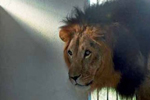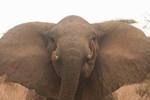Little is known about the silver dik-dik (Madoqua piacentinii) population that roams the dense coastal bushlands of eastern Africa, but experts are working to learn more about the mysterious species.
Weighing little more than a domestic cat, the small antelopes are found in a long, narrow coastal strip spreading across 250 kilometers (155 miles) from Somalia’s capital of Mogadishu north to the port town of Hobyo. This coastal strip is known as the Hobyo Grassland and Shrubland eco-region, according to the WWF.
The eco-region features white and orange sand dunes and endemic species of birds, mammals and reptiles, but political instability has left this area largely unexplored by scientists. Of the four recognized dik-dik species scientists understand silver dik-diks the least.
“We know very little about the actual silver dik-dik distribution in the Horn of Africa,” Giovanni G. Bellani told mongabay.com. As a natural scientist, Bellani studies the zoology and biodiversity of tropical ecosystems, particularly in Africa. “We do not know its ecology, its behavior or its biology.”

Silver dik-dik (Madoqua piacentinii) male, found in Ogaden, Ethiopia. Photo by: Catrin Hammer for AWWP (Al Wabra Wildlife Preservation)/N.e.a.a.s.g. ( North East African subgroup of Antelope Specialist Group of IUCN).
Initially thought to be the same species as the Salt’s dik-dik (Madoqua saltiana), silver dik-diks were classified as a separate species in 1978 based on its consistently smaller size, uniform silvery coat color and the length of the upper tooth row.
Bellani and other scientists are analyzing the physical characteristics of silver dik-diks to further distinguish them from the look-alike Salt’s dik-dik species. The team looked at the differences in coat color and size by examining original photos, skins from the Museum of Zoology and Natural History (La Specola) in Italy, and specimens from the Faraggiana-Ferrandi Museum of Natural History collection, also located in Italy. Bellani published a report of this analysis in the Gnusletter, the bi-annual journal of the IUCN/SSC Antelope Specialist Group (ASG).
All dik-diks have large dark eyes ringed by white hair, and a thick tuft of hair sticks up between the short horns of the males. The group found several distinctive features among silver dik-diks, including size. Silver dik-diks are consistently smaller than the other species, with smaller ears and a less distinct white circle around the eyes. In addition, silver dik-dik individual hairs are black at the tip, followed by a creamy-colored band, then dark brown tinged with red. These alternating bands of light and dark color never exceed 5 millimeters (0.2 inches), but the alternating bands of Salt’s dik-diks often exceed this length, according to the report.
“I hope a detailed DNA analysis and comparison of the silver dik-diks and Salt’s dik-dik will be done to better understand their genetic relationship,” Bellani said.
Scientists also know very little about the actual distribution and population size of silver dik-diks. Scientists originally thought silver dik-diks were limited to Somalia’s coast, but the antelope was recently photographed in the Ogaden region of Ethiopia, which shares a border with Somalia.
In 1999, scientists estimated the population of the silver dik-dik to be 30,000. Even with the new knowledge of their expanded distribution this number may be an overestimate, according to the IUCN Red List. The species is labeled Data Deficient due to a lack of available information.
“The trend of the population size is not precisely known, but it is undoubtedly decreasing,” Bellani said. “The silver dik-dik population lives in areas that are not protected.”
The creatures are often hunted for their highly valued skin and the male’s horns are exported or used to make keychains, Bellani said. Silver dik-diks are also sold live and used to train hunting falcons due to their small stature.
The species may also be experiencing habitat destruction. Years of political unrest due to volatile instability and ongoing conflict in Somalia has created more human activity along the coastal habitat.
“Establishing its actual distribution and population size is urgently needed,” Bellani said. “But field surveys are likely to remain impractical for the near future.”

Two female silver dik-dik in Moscow zoo. Photo by Moscow zoo.

Mounted female specimen of silver dik-dik in the Faraggiana-Ferrandi Natural History Museum in Novara (Italy). Photo by: G.G. Bellani.
CITATION: Bellani. Notes on the silver Dik-dik Madoqua piacentinii Drake-Brockman, 1911. GNUSLETTER I.U.C.N. / A.S.G. Antelope Specialist Group. February 2013 VOL. 31.
Related articles
Featured video: local communities successfully conserve forests in Ethiopia
(04/17/2013) A participatory forest management (PFM) program in Ethiopia has made good on forest preservation and expansion, according a recent article and video interview (below) from the Guardian. After 15 years, the program has aided one community in expanding its forest by 9.2 percent in the last decade, while still allowing community access to forest for smallscale logging in Ethiopia’s Bale Mountains.
Poachers enlisting impoverished wildlife rangers as accomplices in elephant, rhino killing
(04/01/2013) Corruption among wildlife rangers is becoming a serious impediment in the fight against poaching, fuelled by soaring levels of cash offered by criminal poacher syndicates, senior conservation chiefs have admitted. Rangers in countries as diverse as Tanzania and Cambodia are being bribed by increasingly organised poaching gangs keen to supply ivory, rhino horn and tiger parts to meet huge consumer demand in Asia.
Forgotten lions: shedding light on the fate of lions in unprotected areas

(03/18/2013) African lions (Panthera leo) living outside of protected areas like national parks or reserves also happen to be studied much less than those residing within protected areas, to the detriment of lion conservation initiatives. In response to this trend, a group of researchers surveyed an understudied, unprotected region in northwestern Mozambique called the Tete Province, whose geography and proximity to two national parks suggests a presence of lions.
Geneticists discover distinct lion group in squalid conditions

(02/04/2013) They languished behind bars in squalid conditions, their very survival in jeopardy. Outside, an international team of advocates strove to bring worldwide attention to their plight. With modern genetics, the experts sought to prove what they had long believed: that these individuals were special. Like other cases of individuals waiting for rescue from a life of deprivation behind bars, the fate of those held captive might be dramatically altered with the application of genetic science to answer questions of debated identity. Now recent DNA analysis has made it official: this group is special and because of their scientifically confirmed distinctiveness they will soon enjoy greater freedom.
Forests in Kenya worth much more intact says government report

(01/24/2013) Kenya’s forests provide greater services and wealth to the nation when they are left standing. A landmark report by The Kenyan Government and the United Nations Environment Programme (UNEP) addresses the importance of forests to the well-being of the nation, putting Kenya among a pioneering group of countries that aim to center development plans around nature-based assets.
Why it’s time to ban the ivory trade for good [Graphic images: viewer discretion advised]

(12/12/2012) This week the Kenya Wildlife Service (KWS) announced a 14% decline in elephants in the Samburu/Laikipia ecosystem over the last 4 years. The decline has occurred in a population whose natural growth rate was measured at 5.3% between 2002 and 2008 according to the previous survey, suggesting that over 300 elephants are dying annually in the Samburu and Laikipia’s landscape, denting the poster child image of one of Kenya’s most important wildlife landscapes. Poaching and drought are the main causes of mortality in this population. The impact of poaching on tourism cannot be ignored, heavily armed bandits threaten more than elephants, if we can’t protect elephants how can we protect international tourists? But it’s the long term consequence that are of greater concern.
Poaching in Serengeti seems worth the risk
(12/10/2012) Illegal hunting in Tanzania’s Greater Serengeti Ecosystem (GSE) remains a prevalent activity for local people, despite government regulation and grassroots movements to prevent it. A new paper from mongabay.com’s open-access Tropical Conversation Science examines the factors that drive poachers to continue their activities, despite the high costs involved. By interviewing citizens involved with illegal hunting in the Western part of the Serengeti, they were able to identify key risks that are faced by the hunters as well as the perceived gains of a successful hunt.
New inroads made into bushmeat consumption in Tanzania
(12/10/2012) Bushmeat consumption, or “wildlife hunted for human consumption,” poses a significant threat to wildlife conservation all across the globe. But in Eastern Africa—where savannah grasslands flourish and big game roam free within ‘protected’ reserves—one may be forgiven to think that poaching does not occur here: but it does.
Vanishing corridors: trying to keep big animals on the move across Tanzania

(12/10/2012) One of the biggest challenges for big African wildlife like lions, elephants, and buffalo is movement across native habitat that is increasingly being encroached on by humans. Animals find their movement restricted by roads, fences, and property boundaries which fragment the landscape. Without safe, smart, and well-maintained corridors between designated wildlife areas, animals can get cut off from resources needed for survival and from potential mates (putting genetic health at risk), even while conflicts with humans become more frequent.